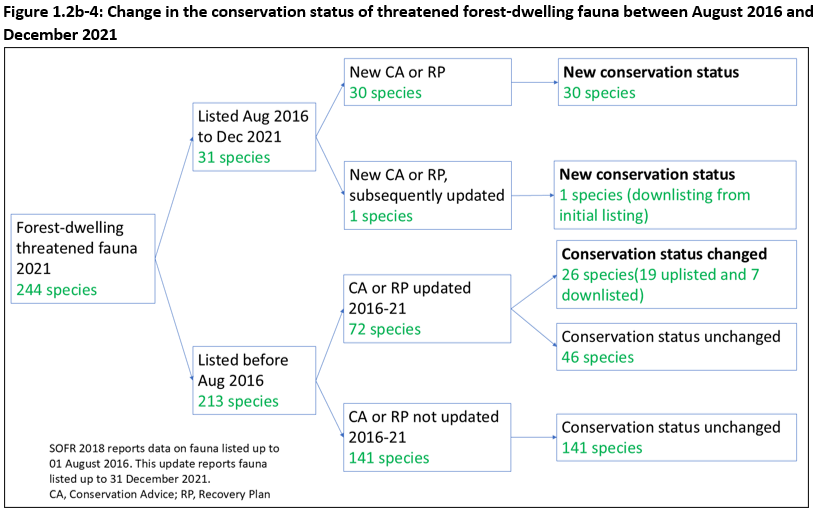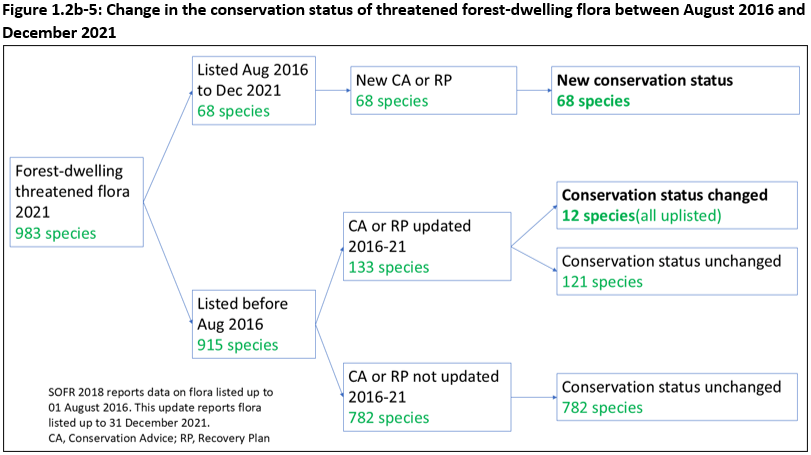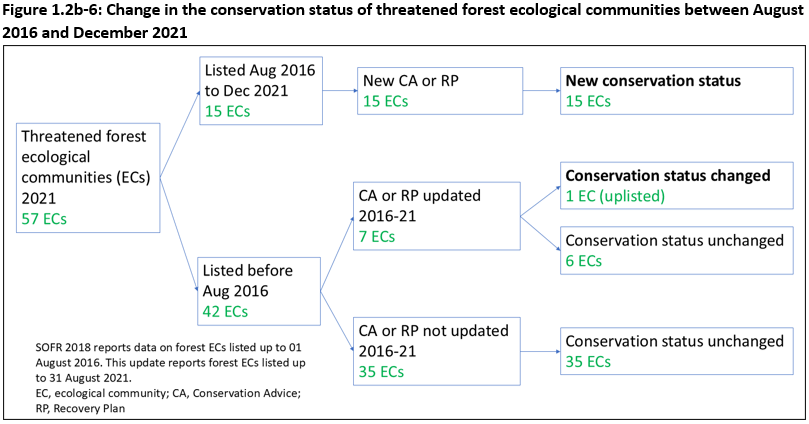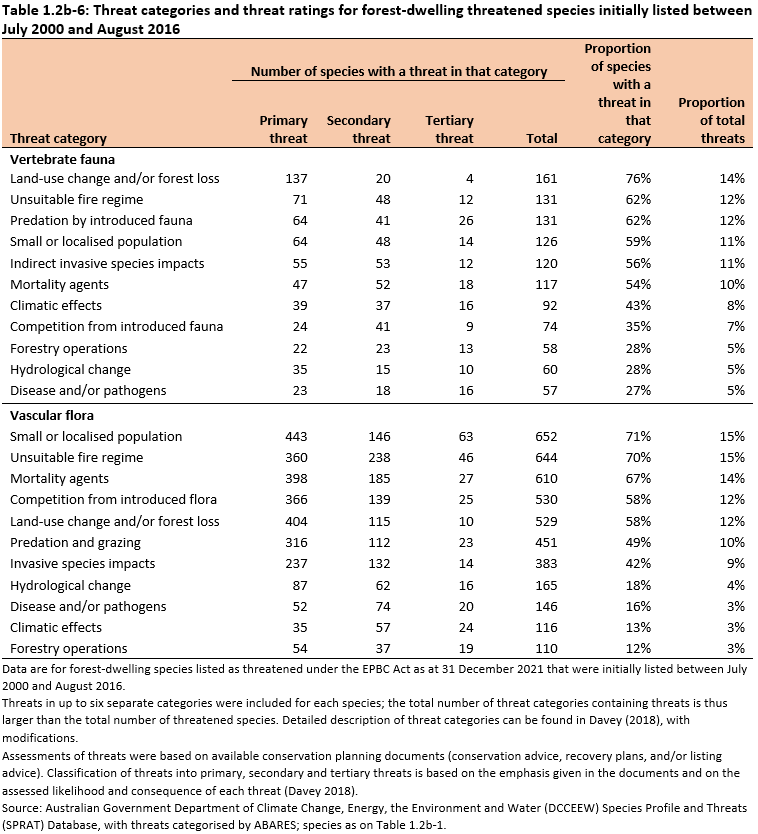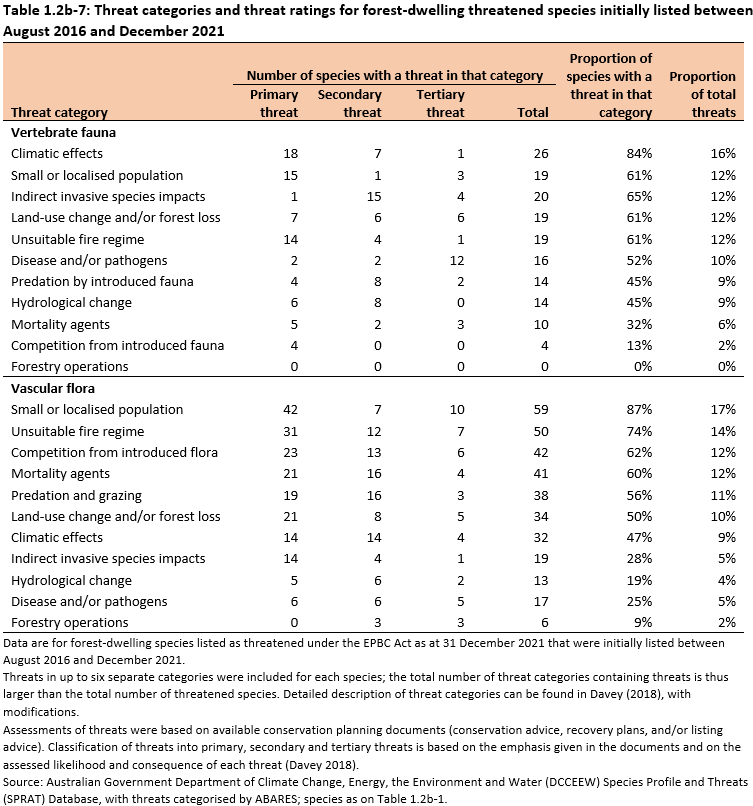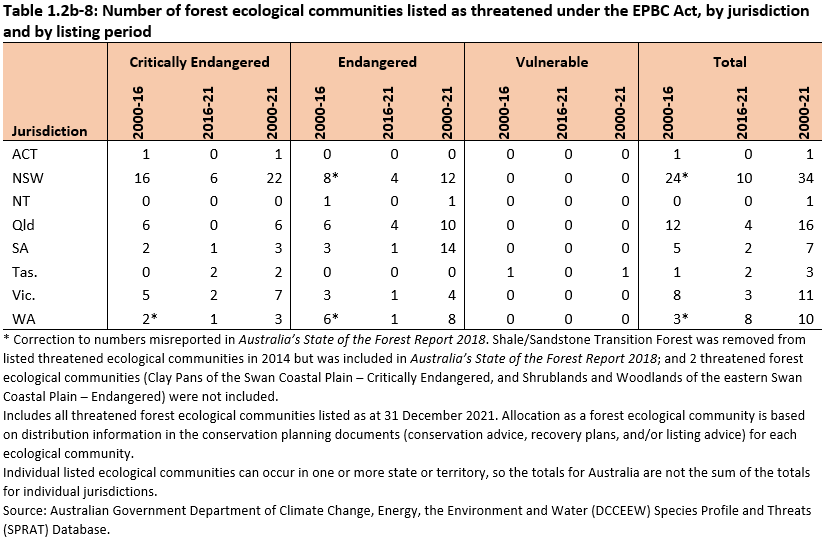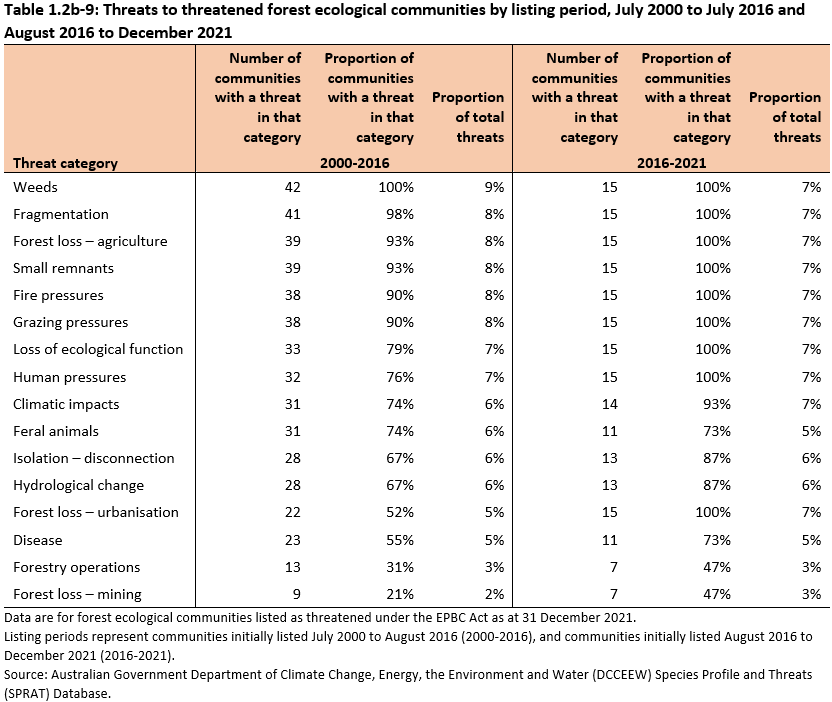This is Supporting information for Indicator 1.2b, published October 2024.
The threatened forest-dwelling species lists presented in this Indicator were derived by intersecting the forest dwelling species lists developed for Indicator 1.2a with the compilation of threatened species listed under the Environment Protection and Biodiversity Conservation Act 1999 (EPBC Act) as at December 2021 (as provided through the Species Profile and Threats (SPRAT) Database).
The species list in Indicator 1.2a contains forest-dwelling vertebrate fauna and vascular flora with distribution within National Forest Inventory (NFI) boundaries, and at species level only, while the EPBC Act threatened list considers infraspecific taxa (i.e. below species level including subspecies, ecotypes, varieties, or hybrids) with distribution not limited by NFI boundaries. Thus, compilation of threatened forest-dwelling species was extended to consider the following:
- Inclusion of forest-dwelling vertebrate fauna and vascular flora separately listed under the EPBC Act as infraspecific taxa. In such cases, habitat requirements for the specific taxa were examined and the infraspecific taxon retained as forest-dwelling only if its habitat requirements include forests.
- Inclusion of threatened vertebrate fauna and vascular flora assessed as inhabiting forests but that do not have sufficient Atlas of Living Australia records to have been classified as forest-dwelling for Indicator 1.2a, for example through rarity.
- Inclusion of forest-dwelling species with names not (or not yet) accepted by the Australian Plant Census or Australian Faunal Directory, and duplicates listed separately as threatened taxa.
- Exclusion of threatened forest-dwelling species found exclusively outside NFI boundaries (taxa found exclusively on external territories such as Norfolk Island, Lord Howe Island, Christmas Island, and Cocos (Keeling) Islands).
The resultant list of threatened forest-dwelling species contained 244 threatened vertebrate fauna and 983 threatened flora, and is available for download from forest species and ecological communities data.
The threatened forest ecological communities list was developed by examining the conservation planning documents (conservation advice and/or recovery plans) of the 94 threatened ecological communities listed as at December 2021, as provided through the SPRAT database. Of these, 57 are forest ecological communities.
Threats relating to listed threatened forest-dwelling fauna and flora were assessed and categorised from information in available conservation planning documents (conservation advice and/or recovery plans) and listing advice.
Threats were grouped into threat categories following Davey (2018) and Australia’s State of the Forest Report 2018, with one exception. The ‘Invasive species’ category previously used solely for threats from invasive species specified as key threatening processes under the EPBC Act was not maintained. Instead, a new threat category of ‘Indirect invasive species impacts’ was created for threats other than competition and predation: examples are toxic ingestion of cane toads, trampling of riparian habitat by feral pigs, fouling of rock habitat by feral goats, and invasive weeds that can change floristic composition, habitat structure and flammability.
Threats in up to six threat categories were allocated for each forest-dwelling species, using the six greatest threats if a species had threats in more than six categories. Analysis on threats and determination of ranks are based on the information described in the conservation planning documents. Threats were ranked as primary, secondary or tertiary based on the impact and likelihood (Davey 2018). Primary threats refer to known (certain and most likely) threats with major and extreme impacts. Secondary threats refer to known threats with moderate impacts or to threats that are likely to occur but when they do occur, they do not have major or extreme impacts on the species. Tertiary threats refer to threats with minor impacts or with low likelihood to occur. Evidence description of threats, emphasis of threats and other threat parameters available from conservation planning documents such as timing (current, future, past threats), confidence (observed, suspected, or inferred), trend (decreasing, static, or increasing), and extent (occurs across the entire range or only part of the range) were also used to guide the determination of the threat rank.
Threats to ecological communities were also assessed based on information in conservation planning documents. Threats for ecological communities were not analysed by rank (primary, secondary, tertiary). Unlike for species threat assessments, all threats specified for ecological communities were included in the calculation of total threats.
Information on threats is presented for three listing periods to identify changes in the main threats to species:
- all threatened forest-dwelling species listed as either Critically Endangered, Endangered or Vulnerable, as at December 2021
- recently listed forest-dwelling species, being species with a date of first listing between August 2016 and December 2021
- forest-dwelling species initially listed prior to August 2016.
The data are not directly comparable to data presented in Australia’s State of the Forests Report 2018 because of changes in the treatment of extinct species, species on external territories outside the National Forest Inventory boundaries, and some species now assessed as not inhabiting forest. Thus, to facilitate comparison of threats overtime, a completely new threat analysis was conducted for all threatened species listed as at December 2021. The new analysis was undertaken to filter out species not meeting the current definition of forest-dwelling species, addressing the revision of one threat category (Indirect invasive species impacts), as well as to eliminate assessors’ differences in assigning threat categories and ranking. This approach has allowed for a more robust comparative analysis to determine whether the main threats (reasons for species listing) during the current reporting period (August 2016 to December 2021) differ from for species listed between July 2000 to August 2016.
Changes to conservation planning documents and conservation status for the threatened forest-dwelling species and forest ecological communities between August 2016 and December 2021 are summarised in Figures 1.2b-4, 1.2b 5 and 1.2b-6.
The analysis of threat categories by listing period is aimed at identifying changes of threats over time which can be useful to inform decision making in forest management and biodiversity conservation.
Tables that summarise threats for all threatened forest-dwelling species and ecological communities listed as at December 2021 are presented in the Key information for Indicator 1.2b (Table 1.2b-3 and Table 1.2b-5). Information on threats differentiated by listing period (listing between July 2000 and August 2016; and listing between August 2016 to December 2021) are presented here.
Click here for a Microsoft Excel workbook of the data for Table 1.2b-6.
Click here for a Microsoft Excel workbook of the data for Table 1.2b-7.
Click here for a Microsoft Excel workbook of the data for Table 1.2b-8.
Click here for a Microsoft Excel workbook of the data for Table 1.2b-9.
As at the end of December 2021, there were 21 key threatening processes listed under the Environment Protection and Biodiversity Conservation Act 1999, 18 of which are direct threats to forest-dwelling species and forest ecological communities (Table 1.2b-10).
Table 1.2b-10: Listed key threatening processes affecting forest-dwelling threatened species and forest ecological communities as at December 2021
| Key threatening processes | Effective datea |
|---|---|
| Competition and land degradation by rabbits | 16 July 2000 |
| Competition and land degradation by unmanaged goats | 16 July 2000 |
| Dieback caused by the root-rot fungus (Phytophthora cinnamomi) | 16 July 2000 |
| Predation by European red fox | 16 July 2000 |
| Predation by feral cats | 16 July 2000 |
| Land clearance | 4 April 2001 |
| Loss of climatic habitat caused by anthropogenic emissions of greenhouse gases | 4 April 2001 |
| Psittacine circoviral (beak-and-feather) disease affecting endangered psittacine species | 4 April 2001 |
| Predation, habitat degradation, competition and disease transmission by feral pigs | 6 August 2001 |
| Infection of amphibians with chytrid fungus, resulting in chytridiomycosis | 23 July 2002 |
| The reduction in the biodiversity of Australian native fauna and flora due to the red imported fire ant, Solenopsis invicta | 2 April 2003 |
| Loss of biodiversity and ecosystem integrity following invasion by the yellow crazy ant (Anoplolepis gracilipes) on Christmas Island, Indian Ocean | 12 April 2005 |
| Biological effects, including lethal toxic ingestion, caused by cane toads (Bufo marinusb) | 12 April 2005 |
| Predation by exotic rats on Australian offshore islands of less than 1,000 km2 (100,000 hectares) | 29 March 2006 |
| Invasion of northern Australia by gamba grass and other introduced grasses | 16 September 2009 |
| Loss and degradation of native plant and animal habitat by invasion of escaped garden plants, including aquatic plants | 8 January 2010 |
| Novel biota and their impact on biodiversity | 26 February 2013 |
| Aggressive exclusion of birds from potential woodland and forest habitat by over-abundant noisy miners (Manorina melanocephala) | 9 May 2014 |
a Date from which the threatening process was listed.
b Current scientific name Rhinella marina.
Source: DCCEEW (2023).
ABARES (2018). Forests of Australia (2018), Australian Bureau of Agricultural and Resource Economics and Sciences, Canberra, December. CC BY 4.0 doi.org/10.25814/5c59170ec780d
ABARES (2024). Forest-dwelling species and threatened forest ecological communities of Australia dataset (2024), Australian Bureau of Agricultural and Resource Economics and Sciences, Canberra, October. CC BY 4.0. This dataset includes the forest-dwelling fauna and flora lists complied for Indicator 1.2a (2024).
Australian Government Department of Climate Change, Energy, the Environment and Water (DCCEEW) Species Profile and Threats (SPRAT) Database environment.gov.au/cgi-bin/sprat/public/sprat.pl.
MIG and NFISC (Montreal Process Implementation Group for Australia and National Forest Inventory Steering Committee) (2024). Indicator 1.2a: Forest-dwelling species for which ecological information is available, Australia’s State of the Forests Report, Australian Bureau of Agricultural and Resource Economics and Sciences, Canberra, October. CC BY 4.0.
ABARES (2024). Forest-dwelling species and threatened forest ecological communities of Australia dataset (2024), Australian Bureau of Agricultural and Resource Economics and Sciences, Canberra, December. CC BY 4.0. doi.org/10.25814/1jy9-5y51
Montreal Process Implementation Group for Australia (MIG) (2008). Australia’s State of the Forests Report 2008, Bureau of Rural Sciences, Canberra.
Davey SM (2018). Reporting Australia’s forest biodiversity II: threatened forest-dwelling and forest-dependent species, Australian Forestry 81(4):214-230. doi.org/10.1080/00049158.2018.1510627
DCCEEW (2022). Threatened Species Action Plan 2022-2032, Australian Government Department of Climate Change, Energy, the Environment and Water, Canberra, September. CC BY 4.0
DCCEEW (2023). Key threatening processes under the EPBC Act, Australian Government Department of Climate Change, Energy, the Environment and Water, Canberra, accessed 31 March 2023.
Further information
- Key points
- Protecting listed threatened forest-dwelling species and ecological communities
- Threatened forest-dwelling species
- Changes in the conservation status of threatened forest-dwelling species
- Threats to threatened forest-dwelling species
- Threatened forest ecological communities
- Threats to threatened forest ecological communities
Downloads
- Indicator 1.2b: The status of forest dwelling species at risk of not maintaining viable breeding populations, as determined by legislation or scientific assessment (2024) - PDF [1.7 MB]
- Tabular data for Indicator 1.2b - Microsoft Excel workbook [0.1 MB]
- Forest-dwelling species and threatened forest ecological communities of Australia dataset (2024) - Microsoft Excel workbook [1.3 MB]
- Metadata - Forest-dwelling species and threatened forest ecological communities of Australia dataset (2024) - PDF [0.2 MB]

